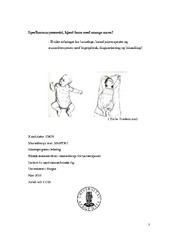| dc.contributor.author | Norheim, Bente Ingvei | en_US |
| dc.date.accessioned | 2011-10-12T12:22:19Z | |
| dc.date.available | 2011-10-12T12:22:19Z | |
| dc.date.issued | 2010-11-30 | eng |
| dc.date.submitted | 2010-11-30 | eng |
| dc.identifier.uri | https://hdl.handle.net/1956/5062 | |
| dc.description.abstract | Background: There is confusion about how different health professions understand the concepts of infant asymmetry and torticollis. Traditionally, the condition is called torticollis and the causal explanation has been damage or shortening of the sternocleidomastoid muscle, and the treatment has been stretching. KISS or dysfunction in the upper cervical spine is another term used recently, and the treatment is suggested to be mobility- enhancing techniques. Aim and objectives: To investigate how pediatric physiotherapists, manual therapists and a pediatrician interpret the term infant asymmetry, the causes and management of this condition, and whether subgroups may be defined. Material and method: Two focus group interviews, one with manual therapists (n = 7) and one with pediatric physiotherapists (n = 7) and in-depth interviews with two key informants, a manual therapist and a pediatrician. All respondents had extensive experience with infant asymmetry. Results: The results indicated that different concepts and diagnoses were used to describe this condition. The respondents had different views on the need for follow-up and treatment of infant asymmetry. Different opinions were claimed to lead to confusion and frustration among parents and professionals. The informants believed infant asymmetry must be classified into subgroups for optimal diagnosis and treatment and they underscored that stretching was not widely used presently. Conclusion: The study indicated that health professionals perceived that the infant asymmetry can be divided into subgroups. More research is needed to ensure each child optimal treatment. Common terminology should be standardized. | en_US |
| dc.description.abstract | Bakgrunn: Det hersker forvirring omkring hvordan forskjellige helseprofesjoner oppfatter begrepene torticollis og spedbarnsasymmetri. Tradisjonelt har tilstanden blitt kalt torticollis og årsaksforklaringen har vært skade eller forkorting av muskelen sternocleidomastoideus, og behandlingen har vært tøyninger. KISS eller funksjonsforstyrrelse i øvre nakkeledd er et annet begrep for spedbarnsasymmetri og forklares som nedsatt bevegelighet i barnets nakkeledd, og behandles med bevegelighetsfremmende teknikker. Hensikt: Undersøke hvordan barnefysio- og manuellterapeuter og barnelege oppfatter begrepet spedbarnsasymmetri, årsaksforhold og oppfølgingen av dette problemområdet, samt om de tror det finnes subgrupper av spedbarnsasymmetri. Materiale og metode: To fokusgruppeintervju, en med manuellterapeuter (n=7) og en med barnefysioterapeuter (n=7) og dybdeintervju med to nøkkelinformanter, en manuellterapeut og en barnelege, ble benyttet for å belyse problemstillingen. Alle informantene hadde bred erfaring med spedbarnsasymmetri. Resultat: Resultatene viste at forskjellige begrep og diagnoser ble brukt og at informantene hadde forskjellig syn på behov for oppfølging av spedbarnsasymmetri. Forskjellig oppfatning ble hevdet å kunne føre til misforståelser og frustrasjon blant foreldre og fagfolk. Informantene mente spedbarnsasymmetri må klassifiseres i undergrupper for optimal diagnostisering og behandling og hevdet at tøyning ble brukt i mindre grad i dag. Konklusjon: Studien indikerte at helsepersonell oppfattet at spedbarnsasymmetri kan deles i flere subgrupper og at mer forskning trengs for å sikre hvert barn optimal diagnostisering og behandling. Det bør jobbes for felles begrepsbruk. | en_US |
| dc.format.extent | 713025 bytes | eng |
| dc.format.mimetype | application/pdf | eng |
| dc.language.iso | nob | eng |
| dc.publisher | The University of Bergen | eng |
| dc.subject | Torticollis | nob |
| dc.subject | Manuellterapi | nob |
| dc.subject | Fysioterapi | nob |
| dc.subject | Spedbarn | nob |
| dc.title | Spedbarnsasymmetri, kjært barn med mange navn? Hvilke erfaringer har barnelege, barnefysioterapeuter og manuellterapeuter med begrepsbruk, diagnostisering og behandling? | en_US |
| dc.type | Master thesis | |
| dc.rights.holder | Copyright the author. All rights reserved | |
| dc.rights.holder | The author | |
| dc.description.degree | Master i Klinisk masterstudium for fysioterapeuter i manuell terapi (MFMT | |
| dc.description.localcode | MAMD-MANT | |
| dc.description.localcode | MANT395 | |
| dc.subject.nus | 761901 | eng |
| dc.subject.nsi | VDP::Medical disciplines: 700::Clinical medical disciplines: 750::Physical medicine and rehabilitation: 764 | eng |
| fs.subjectcode | MANT395 | |
